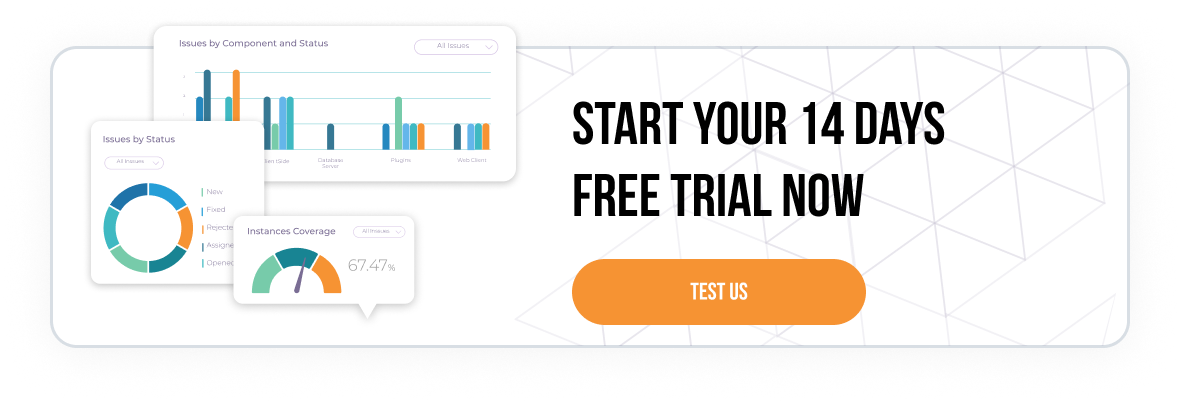Beyond Hierarchical Structures: Agile Test Case Organization
In This blog
While hierarchical folder structures have been a mainstay in test management, their limitations in handling complex projects and evolving testing needs are becoming increasingly apparent. This blog delves into the power of custom fields and dynamic filters, empowering you to break free from rigid hierarchies and create a test case management system that truly adapts to your project’s unique requirements.

The Flawed Hierarchy: One Size Doesn’t Fit All
Traditional hierarchical structures often force you to categorize test cases into a single predefined folder. This becomes problematic when:
-
Projects Grow in Complexity: With extensive functionality and intricate components, fitting all test cases neatly into a limited folder hierarchy becomes an exercise in frustration.
-
Multi-Dimensional Testing: Modern testing approaches, like Behavior-Driven Development (BDD), require considering multiple facets, such as user stories, business interests, and technical components. These facets might not fit smoothly to a single folder hierarchy.
-
Evolving Testing Strategies: As your project progresses and testing methodologies adapt, hierarchical structures can become restrictive, making it difficult to reorganize test cases effectively.
The Liberation of Custom Fields and Dynamic Filtering
Custom fields and filters offer a paradigm shift, allowing you to create a more flexible and dynamic test case management system.
Custom Fields
Custom fields empower QA managers and testers to customize tests according to the unique project’s needs. This could include fields like “Test Type” (manual, automated), “Test Level” (Unit, Integration, Acceptance), “Operating System” (macOS, Windows, Linux), or any other relevant attributes.
Another important advantage of custom fields is the ability to assign more than one value for enhanced categorization. For instance, a test case can be marked as “Functional” and “API” simultaneously.
Filters
Filters allow managing testing data in a dynamic and effective way rather than a static way when using folders. QA teams can implement filters based on various criteria, such as user stories, modules, technical components, or any other relevant grouping factor.
In addition, when assigning multiple filters to each test case it enables granular categorization. This allows you to filter and run tests based on various combinations of filter selections, and find your relevant data even quicker.
Benefits of Filters:
-
Efficient Navigation: Filters eliminate the need to navigate through a complex folder hierarchy to locate specific test cases.
-
Focus on Specific Aspects: You can filter by specific criteria, such as test type or functionality, to prioritize testing efforts.
-
Adaptability: As testing needs evolve, you can easily add new filters or adjust existing ones without restructuring the entire system.
By embracing custom fields and filters, we can bypass the obstacles of hierarchical folders. This approach empowers you to create a test case management system that adapts seamlessly to your project’s unique requirements, fostering efficiency and effectiveness throughout the testing lifecycle.
How Would the Difference Look in Real-Life Scenarios?
In order to emphasize the difference between custom fields and filters to hierarchical folders, in this section, we will give two examples of real-life scenarios.
#1 E-commerce Website
This scenario explores managing test cases for an e-commerce website using a hierarchical folder structure compared to a system with custom fields and filters. We will compare how it would be designed in hierarchy folders structure vs custom Fields structure.
Scenario: Testing a new feature that allows users to create wishlists.
Hierarchical Folders:
- E-commerce Website
- User Management
- Login
- Registration
- Account Settings
- Product Catalog
- Search Products
- View Product Details
- Add to Cart
- Shopping Cart
- View Cart
- Update Cart Quantities
- Remove Items from Cart
- Proceed to Checkout
- Wishlist (New Feature) * Create Wishlist
- Add Items to Wishlist
- Remove Items from Wishlist
- View Wishlist
- User Management
Limitations of Folders:
-
The “Wishlist” folder feels isolated from the core functionalities of the website.
-
It doesn’t reflect the relationship between the wishlist feature and user accounts or product browsing.
-
Adding functionalities related to sharing wishlists or integrating them with social media would require creating new subfolders, potentially making the hierarchy even more complex.
How Would It Look with Custom Fields and Filters?
Custom Fields:
- Test Case ID (a unique identifier for each test case)
- Test Case Description (a brief summary of the test)
- Module (custom field with dropdown options like “User Management,” “Product Catalog,” “Shopping Cart,” and “Wishlist”)
- Feature (another custom field with options like “Login,” “Search Products,” “Add to Cart,” “Create Wishlist,” etc.)
- Test Step (detailed steps for each test)
- Expected Result (anticipated outcome for each step)
Filters:
- Filter by Module: This allows grouping tests related to specific functionalities like “Wishlist.”
- Filter by Feature: You can filter for tests covering wishlist creation, adding items, or other functionalities within the wishlist feature.
- Combine filters to find specific tests. For example, filter by “Module: Wishlist” and “Feature: Create Wishlist” to see all tests related to creating a wishlist.
Key Benefits:
- Flexibility: Update or change a sub-element of the structure quickly and easily. New features like social media integration for wishlists wouldn’t require restructuring the entire folder hierarchy. Just add a new option to the “Feature” custom field.
- Relationships: The “Module” and “Feature” fields establish clear relationships between different functionalities and the wishlist feature.
- Filtering Power: Filtering by various combinations allows the test manager to efficiently locate specific tests without navigating through a complex folder structure.
- Ease of Use: When structured correctly, data can automatically appear on the relevant filter, without the user needing to take an action.
Conclusion:
Custom fields and filters offer a more scalable and adaptable approach for managing test cases, especially for complex projects with evolving requirements. While hierarchical folders provide a basic structure, they can become limiting as projects grow in complexity. By embracing custom fields and filters, test managers gain a more flexible and efficient way to organize and manage their test case libraries.
#2 SAP Upgrade
This case explores managing test cases for a project involving a SAP upgrade, focusing on the Procurement module. We will compare how it would be designed in a hierarchy folder structure vs using custom fields.
Scenario: Testing the functionality of the SAP upgraded Procurement module.
Hierarchical Folders:
- SAP Upgrade
- Finance
- Materials Management
- Sales & Distribution
- Human Resources
- Procurement
- Create Purchase Order
- Manual Tests
- Regression
- Sainty
- Functionality
- Automated Tests
- Regression
- Mobile App
- IOS
- Android
- Web Version
- Edge
- Chrome
- Firefox
- Mobile App
- Sainty
- Functionality
- Regression
- Manual Tests
- Edit Purchase Order
- Approve Purchase Orders
- Manage Vendors
- Material Management Integration (New Functionality)
- Create Purchase Order
Limitations of Folders:
-
The hierarchy becomes complicated, especially with many modules being upgraded. Difficult finding tests.
-
When there is an update for a regression test, there is a need to update it on each folder separately, which is time-consuming and inefficient.
-
Adding functionalities related to data migration or specific user roles within Procurement would require creating more subfolders, increasing complexity.
How Would It Look with Custom Fields and Filters?
Custom Fields:
- Test Case ID (a unique identifier for each test case)
- Module (custom field with dropdown options like “Finance,” “Materials Management,” “Sales & Distribution,” “Human Resources,” and “Procurement”)
- Sub-Module (another custom field specific to Procurement, with options like “Create PO,” “Edit PO,” “Approve PO,” and “Manage Vendors”)
- Functionality (custom field with options like “Standard Functionality,” “New Functionality,” and “Regression Testing”)
Filters:
- Filter by Module: This allows grouping tests related to specific modules like “Procurement.
- Filter by Sub-Module: You can filter for tests covering specific functionalities within Procurement, such as “Create PO” or “Manage Vendors.”
- Filter by Functionality: This helps identify tests related to new functionalities introduced in the upgrade or regression tests for existing functionalities.
- Combine filters to find specific tests. For example, filter by “Module: Procurement,” “Sub-Module: Create PO,” and “Functionality: New Functionality” to see all tests related to creating a purchase order after the upgrade.
Key Benefits:
- Granular Organization:: Custom fields like “Sub-Module” and “Functionality” provide a more detailed breakdown of test cases within the Procurement module.
- Efficient Navigation:: Filtering eliminates the need to navigate through a complex folder hierarchy to locate specific test cases.
- Easy Maintenance: Filtering tests removes the need to create endless folders and sub-folders, which results in easy, smooth editing of test cases in a fraction of the time.
Conclusion:
Custom fields and filters offer a more organized and adaptable approach for managing test cases in an SAP upgrade project. They provide a clear structure for categorizing tests based on modules, sub-modules, functionalities, and data migration considerations. This flexibility empowers the test manager to efficiently locate and execute relevant test cases, ensuring a thorough and successful upgrade process.
The Benefits of Freedom: Why Embrace Custom Fields and Filters?
-
Enhanced Flexibility: Organize test cases based on a multitude of attributes, not just a single hierarchy. This makes it easier to find the right test cases and group them for efficient execution.
-
Improved Maintainability: As project requirements and testing strategies evolve, you can easily adjust your categorization system without having to painstakingly reorganize folders.
-
Streamlined Test Execution: Filter and run test cases based on specific combinations of custom field values, enabling targeted testing and optimizing execution time.
-
Boosted Collaboration: Easy to jump in and start working with clear filtering capabilities. Whether you are new to the organization or not, this enhanced shared understanding contributes to better team communication and collaboration on testing activities.
To Sum Up
Custom fields and tags provide an escape hatch from the limitations of rigid hierarchies. By harnessing their power, you can create a dynamic test case management system that scales with your project’s complexity, effortlessly adapts to evolving testing needs, and empowers your team to execute tests more efficiently and effectively.
Consider implementing a modern test management platform such as PractiTest, that supports custom fields and dynamic filtering capabilities to unlock a world of flexibility and enhance your testing efficiency.

























